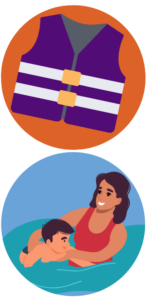
04 Jun Safety First—National Child Safety Week
National Child Safety Week is the first week in June—making it the perfect time to talk with parents about ways to keep children safe. According to the National Library of Medicine and the CDC, the leading causes of death in children and adolescents in the US are firearms, motor vehicle accidents, and accidents in general. It’s important to consider the age of the child as well. For teens, the leading causes of death include homicide and suicide.
The Facts:
In 2020, firearm-related injuries became the leading cause of death in children and adolescents, with 45,222 firearm-related deaths reported by the National Library of Medicine. This was followed by deaths from motor vehicle accidents, drug overdose and poisoning, cancer or other diseases, suffocation, and drowning.
Active Parenting programs include in-depth sections on safety. Here are some tips to get you started:
For all ages:
- Keep firearms unloaded and locked up. See our blog on the importance of Gun Safety.
- Wear seatbelts. Check out the Child Passenger Safety article from the CDC and read about Car seats and booster seats (United States Department of Transportation)
- Have the Poison Control number stored on your phone or somewhere you can find it quickly.
Poison Control: 1-800-222-1222. - Install smoke alarms and carbon monoxide detectors and change the batteries twice a year.
- Have fire extinguishers handy and know how to use them.
 WATER SAFETY
WATER SAFETY
- Children should not be near water without an adult.
- Children or teens who cannot swim should wear a life jacket.
- According to the American Academy of Pediatrics (AAP), children can start swim lessons at age 1—learning skills like floating and finding the wall or an exit point. The AAP recommends children learn to swim around age 4, focusing on treading water and basic swim strokes.
Children ages 0-5:
For a more comprehensive list, check out our SAFE HOME CHECKLIST in the Active Parenting: First Five Years program and Parent’s Guide.
- Make sure toys are age-appropriate. Do not give young children toys with pieces smaller than a walnut, these are a choking hazard.
- Keep medication in child-proof containers out of reach.
- Remove poisonous plants (see Poison Control’s list of poisonous plants)
- Keep the dryer and washing machine closed or make sure children cannot get access to them.
- Cover electrical outlets.
- Keep glass out of the child’s reach.
- Make sure shelves are secure.
- Ensure that electrical cords are out of the way.
- Put child safety gates at the top & bottom of the stairs.
- Ensure that children cannot get into the garage.
 KITCHEN:
KITCHEN:
- Turn pan handles in towards the back so toddlers can’t pull them off the stove.
- Keep cleaners, paints, plastic bags, and alcohol in cabinets that children cannot access or put a child safety lock on the door.
- Keep knives away from the edge of counters where they could be pulled down by curious toddlers.
BATHROOM:
- Put a rubber mat in the bathtub or shower, use an infant tub for infants.
- If you can, lower the temperature on your hot water heater to 120 degrees at the most or use a hot water faucet guard.
- NEVER leave a child alone in the bathtub.
Ages 5-12:
This is a good time to start talking to kids about the rules regarding violence (including bullying) and the use of tobacco, alcohol, and other drugs. It is also a good time to establish rules for internet safety. You can find guidelines for these regular prevention talks in the Active Parenting 4th Edition Parent’s Guide. Parents can share their values and keep the dialogue open using active listening skills.
Ages 12-18:
As parents, our goal is to balance protecting our children from unnecessary risks with encouraging them to take healthy ones. At the same time, we must prepare our children to survive and thrive in the world. Chapters 5 and 6 of the Active Parenting of Teens Parent’s Guide takes a comprehensive look at reducing the risks of drugs, sexuality, and violence including 10 Prevention Strategies:
- Be a positive role model and teacher of values.
- Educate teens about the risks of drugs, sexuality, and violence.
- Filter OUT negative influences and Filter IN positive influences.
- Establish CLEAR guidelines for behavior.
- Monitor teen behavior.
- Work with other parents—have a support group.
- Provide healthy opportunities for challenge—healthy risks. You must reach to grow.
- Talk with teens about how to resist peer pressure.
- Identify and confront high-risk behavior.
- In the event of a crisis, manage it calmly.
Once Teenagers obtain their driver’s license, they are allowed to drive without supervision. It is crucial that teens are prepared and understand the importance of safety. Parents can find talking points in the CDC’s Teen Drivers article, as well as a Parent-Teen Driving Agreement.
It is important to have fun, but parents also need to ensure safety. Kids do not have fully developed brains yet and may not be able to recognize the risks and consequences of certain behaviors. Therefore, a safety-first approach should guide every family. This means keeping firearms locked away, ensuring that seatbelts are fastened, wearing helmets while biking, and supervising children near water.
MORE RESOURCES:
- Water Safety Resources from the American Red Cross.
- Learn The 5 Layers Of Protection from the National Drowning Prevention Alliance
- Accident Risk Safety Fact Sheets from the Child Accident Prevention Trust
- Pedestrian, Bicycle, and Motorcycle Safety from the CDC
- CPR and First Aid Training (including choking, allergic reactions, & burns) for Parents from the American Red Cross

Active Parenting Publishers founder and president Michael H. Popkin, Ph.D. has been providing research-based education programs with an emphasis on nonviolent discipline, mutual respect, and open communication for 40 years. He is widely known for his expertise in the field of parent education and has appeared on over 100 TV programs, including CNN and The Oprah Winfrey Show.
STAY IN TOUCH!
Click here to receive the latest news and offers from Active Parenting! And follow us on social media:
Copyright 2024 by Active Parenting Publishers, Inc.

 WATER SAFETY
WATER SAFETY
 KITCHEN:
KITCHEN: